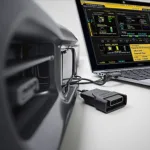The OBD2 connector specification is crucial for understanding how your vehicle communicates diagnostic information. This guide delves into the intricacies of the OBD2 connector, providing a comprehensive overview of its pinouts, protocols, and applications. We’ll cover everything from the physical layout to the data signals transmitted, empowering you to effectively utilize OBD2 diagnostic tools. You can use a simple OBD2 dongle and a dash app to monitor your vehicle’s performance.
Understanding the OBD2 Connector Pinout
The standardized OBD2 connector, also known as the J1962 connector, is a 16-pin trapezoidal port. Each pin has a specific function, facilitating communication between the vehicle’s electronic control units (ECUs) and the OBD2 scanner. Understanding the pinout is fundamental for troubleshooting and diagnostics.
Pin 1: Manufacturer Discretionary
Pin 2: J1850 Bus+
Pin 3: Manufacturer Discretionary
Pin 4: Chassis Ground
Pin 5: Signal Ground
Pin 6: CAN High (J-2284)
Pin 7: ISO 9141-2 K-Line
Pin 8: Manufacturer Discretionary
Pin 9: Manufacturer Discretionary
Pin 10: J1850 Bus-
Pin 11: Manufacturer Discretionary
Pin 12: Manufacturer Discretionary
Pin 13: Manufacturer Discretionary
Pin 14: CAN Low (J-2284)
Pin 15: ISO 9141-2 L-Line
Pin 16: Battery Power
This standardized pinout ensures compatibility across different vehicle makes and models, simplifying the diagnostic process. For instance, if you encounter an OBD2 P0341 code, understanding the pinout can help you pinpoint the potential issue. You can easily find a J1939 female to OBD2 male adapter if needed.
Decoding OBD2 Communication Protocols
The OBD2 connector specification encompasses several communication protocols, including ISO 9141-2, J1850 PWM, J1850 VPW, CAN, and ISO 15765-4 (CAN extended). Each protocol utilizes different signaling methods to transmit data between the ECUs and the scanner. Understanding these protocols is crucial for selecting the appropriate diagnostic tools and interpreting the retrieved data correctly.
ISO 9141-2
This protocol utilizes a single K-line for communication and is commonly found in older European and Asian vehicles.
J1850 PWM and VPW
These protocols were primarily used by domestic manufacturers. PWM (Pulse Width Modulation) and VPW (Variable Pulse Width) offer different data transmission rates.
CAN (Controller Area Network)
CAN is a high-speed, robust communication protocol widely adopted in modern vehicles. It allows for simultaneous data transmission between multiple ECUs.
ISO 15765-4 (CAN Extended)
This protocol is an extension of the CAN standard, providing increased bandwidth and flexibility.
“Understanding the nuances of each protocol is paramount for accurate diagnostics,” says automotive expert, Dr. Emily Carter, Ph.D. “It allows technicians to effectively communicate with the vehicle’s systems and retrieve the necessary data for troubleshooting.” If you’re working with a specific code like a P01CC OBD2, knowing the communication protocol is essential.
Applications of the OBD2 Connector Specification
Beyond diagnostics, the OBD2 connector specification has various applications, including:
-
Vehicle Performance Monitoring: Real-time data on engine parameters, fuel consumption, and emissions can be accessed through the OBD2 port.
-
Fleet Management: The OBD2 connector enables fleet managers to track vehicle location, monitor driver behavior, and optimize fuel efficiency.
-
Insurance Telematics: Insurance companies utilize OBD2 data to assess driver risk and offer personalized insurance premiums.
-
Emissions Testing: The OBD2 port is used for emissions testing to ensure compliance with environmental regulations.
Conclusion
The OBD2 connector specification is a cornerstone of modern vehicle diagnostics and offers a wealth of information for both professionals and car enthusiasts. Understanding its pinout, communication protocols, and applications empowers you to effectively diagnose and monitor your vehicle’s health. From understanding a 2308 OBD2 code to leveraging advanced diagnostics, mastering the OBD2 connector specification is essential.
FAQ
- What is the purpose of the OBD2 connector?
- How can I identify the OBD2 communication protocol in my vehicle?
- Which pins are responsible for power and ground?
- What are some common applications of the OBD2 connector besides diagnostics?
- Where can I find more information on specific OBD2 trouble codes?
“The OBD2 port is your gateway to understanding your vehicle’s inner workings,” explains automotive engineer, John Miller. “It’s a valuable tool for anyone interested in vehicle maintenance and performance.”
Other potential questions and relevant articles:
- What are the different types of OBD2 scanners available? See our article on “Choosing the Right OBD2 Scanner.”
- How can I use an OBD2 scanner to diagnose car problems? Check out our guide on “OBD2 Diagnostics for Beginners.”
- Can I use the OBD2 port for data logging? Explore our piece on “Data Logging with OBD2.”
Need help? Contact our 24/7 customer support team via WhatsApp: +1(641)206-8880, or Email: [email protected].


